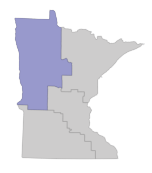
View of the natural landscape in northwestern Minnesota.
The Northwest Region includes 23 counties, and spans all four major ecological provinces of Minnesota; Tallgrass Aspen Parklands, Prairie Parkland, Laurentian Mixed Forest, and Eastern Broadleaf Forest . Wind-swept prairies occur along the western edge with the historic Red River Valley, while majestic pines forests are found in the Itasca and Bemidji areas to the east. In contrast the far northwestern parts of the region include wide-open brushlands, vast forested peatlands, and the large, scenic Lake of the Woods and Red Lakes. This incredible range of habitat means that this region hosts a wide diversity of plant and animal species.

Regional highlights

A calcareous fen native plant community in Ottertail County, Minnesota.
Calcareous Fen Ecology
When the glaciers melted some of that ice water became glacial lakes. Much of western Minnesota was covered by a huge lake called Glacial Lake Agassiz. This lake had beaches and sand dunes. As the lake dried up over time the shoreline receded leaving sand and gravel beach ridges behind. The groundwater flowed up through many spots in the beach ridge, carrying calcium rich water which created calcareous fens. This is one of the most endangered plant communities in the world. Above is a view down a beach ridge slope into one of those fens in Ottertail County. Regional Ecologists work to identify, map, and assess calcareous fens.
These calcareous fens are home to many rare species such as whorled nutrush and hair-like beak rush which are state threatened.



Above, from left: A measuring tape was laid in this calcareous fen to complete a detailed vegetation survey, called a releve.; Calcareous fens often occur within wet prairies and some plants, like little yellow lady’s -slipper, can be found at the transition zones between these different native plant communities; This photo demonstrates how difficult it can be spot rare plants. Here are a few stems of the state threated sterile sedge (being held) mixed in with other dense vegetation.

Survey plot for rare plants in Hubbard County.
Rare Plant Surveys
Minnesota has many rare plants, and the regional ecologists spend much of their field season surveying for these species. The plants are rare for many reasons, such as they are at the edge of their range, or vulnerable to insect pests, disease, or habitat loss. In the case of key species of calcareous fens, their habitat has always been rare. Loss of habitat is a major threat to many of Minnesota’s rare species and may be due to development, climate change, and lack of natural disturbances.
One species we survey for in the Northwest Region, is the state threatened goblin fern. This forest dwelling species is naturally uncommon and is becoming rarer due to several factors. One major factor contributing to its rarity is forest invasion by nonnative earthworms. The earthworms feed on the fallen leaves and rapidly turn over the organic ground cover that goblin ferns rely. We search for these plants using meander surveys but also use plot-based methods to assess the populations.

Forested rich peatlands, like this one can provide excellent habitat for many of Minnesota’s native orchids.
Forest Conservation and Management
Forested plant communities often provide excellent habitat for many of Minnesota’s native orchids, including several rare species, like the ram’s-head orchids. Our forest orchids come in all shapes, sizes, and colors. Some are pale yellow or light green and blend into the forest floor. Others are more vivid and draw your attention like members of the lady’s-slipper group or calypso orchid. Orchids have complex biology and require specific soil fungi to germinate and survive.
Regional ecologists work with land managers and provide technical guidance to help maintain habitat for these unique plants. This work includes conducting rare plant surveys to inform forest management activities and determine appropriate conservation measures when state-listed plant species are present.





Becky Marty
Regional Ecologist

Nick Jensen
Regional Forest Ecologist

